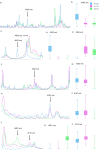Automated web-based typing of Clostridioides difficile ribotypes via MALDI-TOF MS
- PMID: 40676564
- PMCID: PMC12273265
- DOI: 10.1186/s12859-025-06200-6
Automated web-based typing of Clostridioides difficile ribotypes via MALDI-TOF MS
Abstract
Background: Clostridioides difficile is a major cause of hospital-acquired diarrhea and a driver of nosocomial outbreaks, yet rapid, accurate ribotype identification remains challenging. We sought to develop a MALDI-TOF MS-based workflow coupled with machine learning to distinguish epidemic toxigenic ribotypes (RT027 and RT181) from other strains in real time.
Results: We analyzed MALDI-TOF spectra from 379 clinical isolates collected across ten Spanish hospitals and identified seven discriminant biomarker peaks. Two peaks (2463 and 4993 m/z) were uniquely associated with RT027, while combinations of five additional peaks reliably identified RT181. Our classifiers-implemented both in the commercial Clover MSDAS platform and the open-access AutoCdiff web tool-achieved up to 100% balanced accuracy in ribotype assignment and proved robust in real-time outbreak simulations.
Conclusions: This study demonstrates that MALDI-TOF MS combined with tailored machine learning can deliver rapid, high-precision ribotype identification for C. difficile. The freely available AutoCdiff models ( https://bacteria.id ) offer an immediately deployable solution for clinical laboratories, with the potential to enhance outbreak surveillance and control.
Keywords: Biomarker peaks; Classification; Clostridioides difficile; Clostridium difficile; MALDI-TOF MS; Machine learning; Neural network; Outbreak; Random forest; Ribotyping.
© 2025. The Author(s).
Conflict of interest statement
Declarations. Ethics approval and consent to participate: This study was reviewed and approved by the HGUGM Ethics Committee (CEIm) under study number MICRO.HGUGM.2021-025. Because only anonymized microbiological isolates were used and no human specimens or personal data were involved, the Committee waived the requirement for informed consent. Consent for publication: Not applicable Competing interests: MJA and LM are employees of Clover Bioanalytical Software, S.L.
Figures






Similar articles
-
Analysis of high-molecular-weight proteins using MALDI-TOF MS and machine learning for the differentiation of clinically relevant Clostridioides difficile ribotypes.Eur J Clin Microbiol Infect Dis. 2025 Feb;44(2):417-425. doi: 10.1007/s10096-024-05023-2. Epub 2024 Dec 17. Eur J Clin Microbiol Infect Dis. 2025. PMID: 39688756
-
MALDI-TOF MS: An alternative approach for ribotyping Clostridioides difficile isolates in Brazil.Anaerobe. 2021 Jun;69:102351. doi: 10.1016/j.anaerobe.2021.102351. Epub 2021 Feb 20. Anaerobe. 2021. PMID: 33621659 Free PMC article.
-
Whole genome sequence analysis reveals limited diversity among Clostridioides difficile ribotype 027 and 078 isolates collected in 22 hospitals in Berlin and Brandenburg, Germany.Antimicrob Resist Infect Control. 2025 May 28;14(1):56. doi: 10.1186/s13756-025-01565-y. Antimicrob Resist Infect Control. 2025. PMID: 40437588 Free PMC article.
-
Fecal microbiota transplantation for the treatment of recurrent Clostridioides difficile (Clostridium difficile).Cochrane Database Syst Rev. 2023 Apr 25;4(4):CD013871. doi: 10.1002/14651858.CD013871.pub2. Cochrane Database Syst Rev. 2023. PMID: 37096495 Free PMC article.
-
Machine learning and matrix-assisted laser desorption/ionization time-of-flight mass spectra for antimicrobial resistance prediction: A systematic review of recent advancements and future development.J Chromatogr A. 2024 Oct 11;1734:465262. doi: 10.1016/j.chroma.2024.465262. Epub 2024 Aug 23. J Chromatogr A. 2024. PMID: 39197363
References
-
- Viprey VF, Davis GL, Benson AD, Ewin D, Spittal W, Vernon JJ, et al. A point-prevalence study on community and inpatient Clostridioides difficile infections (CDI): results from combatting bacterial resistance in Europe CDI (COMBACTE-CDI), July to November 2018. Eurosurveillance. 2022;27(26):2100704. - PMC - PubMed
-
- Kachrimanidou M, Metallidis S, Tsachouridou O, Harmanus C, Lola V, Protonotariou E, et al. Predominance of Clostridioides difficile PCR ribotype 181 in northern Greece, 2016–2019. Anaerobe. 2022;76: 102601. - PubMed
MeSH terms
Grants and funding
LinkOut - more resources
Full Text Sources

